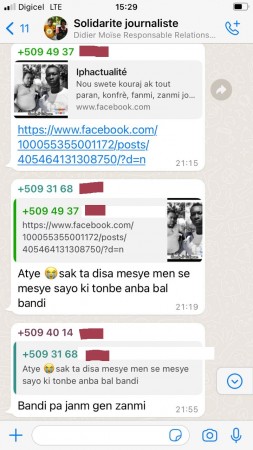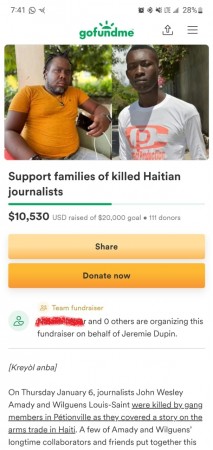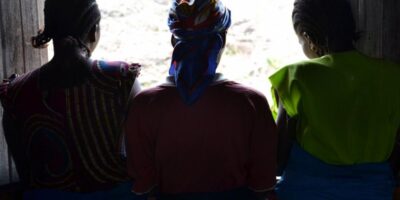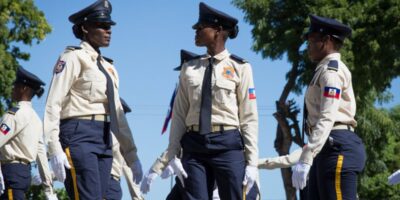John Wesley Amadi was killed in Laboule. Was he a member of the G9 gang, or a journalist too close to the gang leader Jimmy Chérizier?
Lire en Français : Barbecue a payé pour l’enterrement d’un journaliste assassiné
It’s under the rising sun that the group arrived at the crime scene in Laboule 12 on January 7. Two bodies, one of them face down on the ground and the other with a blank expression, facing the sky, are lying near a gully. At least four perforating wounds could be seen on the body of John Wesley Amadi, two in his head and two in his stomach. A pair of projectiles ended up in the skull and neck of his companion, Wilguens Saint-Louis.
The crowd was astonished. Trigger-sensitive gangs share the crevices of the rugged locality overlooking the city of Port-au-Prince. That morning, it took a delegation of about twenty police officers, transported in three visibly overused pickup trucks, twenty journalists from the online media, and a few family members of the victims to retrieve the dead bodies of the professionals brutally murdered the day before, on the heels of a meeting with a local gang.
The group hurriedly put the bodies in body bags. Then, took them to the police station located in Pétion-Ville, twelve minutes from the scene of the tragedy. There, a justice of the peace authorized the transfer of the bodies to the Zenith mortuary located on rue de l’Enterrement.
Amadi and Saint-Louis are members of online media. That is why the journalists accompanied the family to the morgue, as a gesture of solidarity. Inside the funeral home, a journalist approached John Wesley Amadi’s sister at about 11 a.m. Stealthily, he handed her an envelope filled with money, said a witness: it is a gift from Jimmy Cherizier, the fearsome leader of the gang coalition, G9.
The sister of the victim confirmed to AyiboPost that the family had received money from the journalist in question. She revealed that the funeral services, fixed at 300,000 gourdes, did not cost them a penny. Former colleagues contributed. However, she refused to reveal the exact contribution of Barbecue. The press worker also confirmed that he and a colleague served as a liaison between the Delmas 2 kingpin, Barbecue, and the family of the deceased. According to him, « providing this service does not harm anyone. » He requested anonymity for security reasons.
***
The double murder of Laboule 12 splits the online media community. It initiates a debate about the relationship between journalists and gangs, the job of « fixer » for the international media, the precarious situation of media workers, and the ethical gap that consumes many careers. It also highlights the growing impact of global platforms such as YouTube and Facebook, which pay well for » sensational » gang videos, creating an economic opportunity for young people, who are often left to struggle in a low-paid profession.
« John Wesley Amadi was a member of Jimmy Chérizier’s communication team, » says a foreign journalist who had contacted him several times. According to the journalist, Amadi allowed the international press access to Jimmy Chérizier for $3,000 USD. Another journalist reported he asked an average of $3,000 to $5,000 per interview.
The « fixers », a kind of escort for foreign workers, often require large fees, especially in dangerous countries. However, Amadi didn’t seem to stop there. Ahead of one of Barbecue’s many foreign press interviews, he took it upon himself to share the outline of the gang leader’s « development » program for the country. In the field, he took care of the coordination and demonstrated his complicity with the G9 leader.
Lire aussi : Des bandits attaquent cette journaliste à Grand Ravine. Son média l’abandonne.
Amadi also shot most of Jimmy Cherizier’s videos before and even after he began holding press conferences, according to two of his former colleagues. Most of these videos were posted on Barbecue’s Facebook page before the company deleted his account.
John Wesley Amadi was Jeremy Dupin’s driver when he was scheduled to shoot a documentary on Barbecue for the American media outlet Vice in 2020. Dupin says he can neither confirm nor deny accusations of Amadi’s membership in the G9. However, he is aware of his proximity to the gang. Before Amadi’s death, a radio host denounced him in 2021 for his affiliation with illegal armed groups. « There could be journalists paid by the G9 gang, » Dupin said.
A third individual who went with Amadi and St. Louis to Laboule 12 was able to flee during the attack. After the carnage, participants in a WhatsApp group of online media journalists panicked. « Who would have thought that these are the guys who would have been killed by gang bullets, » wrote one participant. « Gangsters never have friends, » said a second group member.

***
There are few laws regulating the journalistic profession in Haiti. It is therefore up to individuals and institutions to put in place clear ethical guidelines where the law is silent.
For the celebrations in Arcahaie on May 18, 2022, Ariel Henry’s government made money available to certain journalists, according to two professionals who were aware of the distributions. NGOs also often hand out « affection » at the end of press conferences, a term referring to the well-established practice of direct money transfers between journalists and their subjects.
The gangs also share some of their profits. An illustration of this way of doing things dates back to the month of August 2021. A confrontation pinning Izo and Manno against the French Embassy in Haiti. The institution accused the gang leaders of attempted extortion; in response, the latter invited online media journalists to a press conference. Six journalists attended.
After the conference, the concept of « affection » was discussed. « We have no money at this time, but someone is due to bring us money from a kidnapping. If you can wait, we will have money for you, » said Manno. According to the testimony of a person close to the journalists who were on the scene, they waited and received a sum in US dollars.
« The question of money was raised by the organizer, » declared one of the journalists in attendance to AyiboPost. « But I didn’t get anything, because the number of views generated by these kinds of videos can make us a lot more money than what the gang leaders are offering us. »
Read also : La police a ciblé des journalistes lors de la manifestation des ouvriers
Monetizing this visual content can be very lucrative. « I sometimes make $300 after posting a video, and I can make about $2,700 a month, » says a community manager with more than 100,000 followers on Facebook.
« Dark » content and content about gangs, are the most watched. Therefore, they generate even more money. To produce these videos, you don’t even need a journalism degree. Amadi didn’t have one. Instead, he had a degree in electronic engineering when he was hired as an antenna manager at Radio Megastar in 2013-2014. According to one of his former colleagues, his salary was very low.
In 2018, while employed by radio Ecoute FM after leaving Megastar, he quickly traveled to gang-controlled areas such as Savien, led by Odma, who is since deceased, or to Jean Denis, fief of Ti Mepri in Artibonite. His videos drew great popularity to this little-known media outlet at the time.
« It is, unfortunately, a form of sensationalism, » observed Harold Isaac, a journalist working in Haiti. He works for many media institutions around the world. Online, these young people engage in unethical competition for attention. It is also rumored that they sometimes financially solicit sources to publish content, which is unethical. Unfortunately, this situation is likely to worsen, « especially with the elections around the corner » Isaac predicts.
***
The quest for sensationalism, for ideological or ratings reasons, also reaches the international media. Since the growth of gangs, foreign journalists often arrive in Haiti, asking gang leaders to be interviewed, sometimes in ways that country experts say are unethical. « Hate messages shared with a wide audience constitues advertising terrorism, » according to security expert James Boyard.
The gangs understand the game and are positioning themselves to take advantage of it. On August 1, 2021, the French media M6 published an « exclusive » investigation on the gangs in Haiti. A few weeks earlier, Amadi and another Haitian journalist had been asked by this media to arrange an interview with Lanmò San Jou, the leader of the 400 Mawozo gang. This gang kidnapped three French members of the religious community on April 11, 2021.
« Lanmò San Jou had asked for $20,000 to do this interview, » the other journalist in charge of negotiating with the gang leader told AyiboPost.
Lire enfin : Ce journaliste a reçu une balle en plein œil. Il revient à la charge.
M6 refused to pay for this interview, according to the media worker. Lanmò San Jou, who is advised by Germine Joly (Yonyon) from his prison cell, would not give the interview free of cost. He would let the French clerics go only after having snorted a white powder in their presence and slaughtering a goat with a machine gun.
However, some foreign media find ways to interview gang leaders without violating the principle of non-payment of sources, which is strongly emphasized in the internal procedures of their respective corporations: « They pay the fixers handsomely, who in turn pay the gangs and their allies, » explains a Haitian journalist who has worked with international media on several occasions.
John Wesley Amadi’s connections to Haitian gangsters has alternately served the local and international media. He lived in a dilapidated house in Wharf Jérémie, controlled by Micanor, and sometimes stayed at the Marriott Hotel in Port-au-Prince, all paid for by foreign companies to get the latest statements from the gangs. When he died, a Go Fund Me page launched in Jeremy Dupin’s name collected $10,530. The goal was was set at $20,000.

Amadi’s body, face down, and that of Wilguens Saint-Louis, with a blank expression, were found near a ravine in Laboule 12, on a Monday of last January. The gangsters stripped the two professionals of their bags and all of their equipment. John Wesley Amadi cadavre was also ridden of a pair of hip sneakers, which were a gift from a team of foreign journalists who landed in Haiti, revealed two sources.
Cover photo by Mackline Jeudy.
English translation by Didenique Jocelyn.







Comments